Fomitopsis betulina (Bull.) B.K. Cui, M.L. Han & Y.C. Dai - Birch Polypore or Razor Strop Fungus
Phylum: Basidiomycota - Class: Agaricomycetes - Order: Polyporales - Family: Fomitopsidaceae
Distribution - Taxonomic History - Etymology - Identification - Culinary Notes - Reference Sources
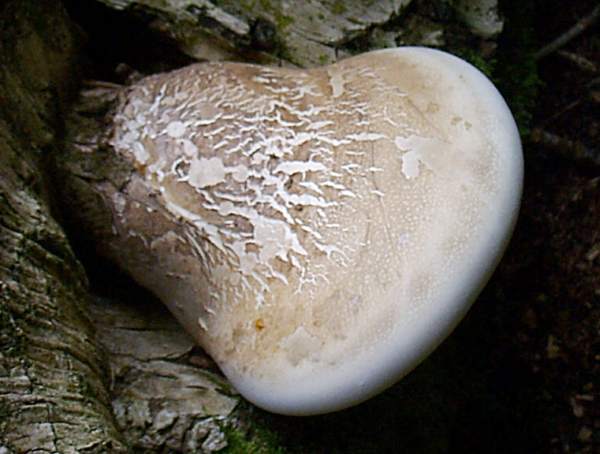
This large polypore develops from a small white spherical swelling on the side of dead or living birch trees. Barbers used to 'strop' or sharpen their cut-throat razors on tough, leathery strips cut from the surfaces of these polypores, and so they became known as the Razor Strop Fungus.
The 5,000 year old mummy found in the Tyrol and nicknamed Ötzi the Iceman was had two pieces of this fungus on a neck thong, and it seems unlikely that their purpose was to sharpen a razor.
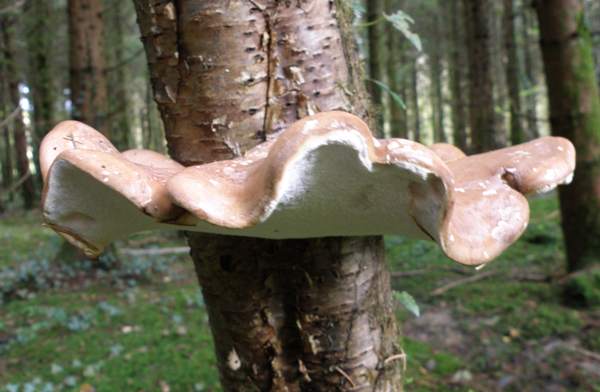
Ötzi, whose frozen mummified corpse was found in September 1991 by hikers just as it had began emerging from the Schnalstal Glacier in the Ötztal Alps on the border between Austria and Italy, is currently on display at the purpose-built South Tyrol Museum of Archaeology in Bolzano (South Tyrol, Italy).
The Birch Polypore was also used by early Man with some kind of spark producing implement such as flint stones to start camp fires at a new campsite - as also was Fomes fomentarius, the Tinder Fungus or Hoof Fungus.
Both of these polypores were used in dried form to carry fire from place to place, because they smoulder very slowly while being transported and can then be fanned into flames upon arrival at a new location - a great help in the days before matches or gas lighters..
Distribution
Very common in Britain and Ireland, the Birch Polypore bracket fungus is found throughout the northern hemisphere, although as with many apparently identical fungi it is as yet unclear whether the form that occurs in North America is truly the same species as (and hence capable of mating with) the one found in Europe.
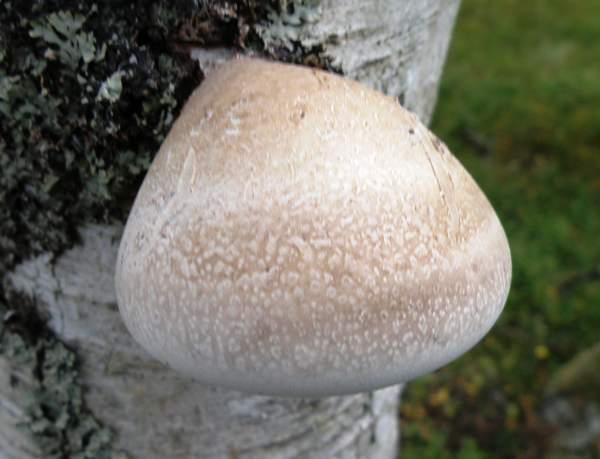
Taxonomic history
In 1753 Carl Linnaeus described this fungus and referred to it as Boletus suberosus, and later the French mycologist Jean Baptiste Francois (Pierre) Bulliard changed the specific epithet to betulinus - a reference to the birch trees (Betula spp.) on which it occurs.
It was Bulliard who, in 1787-88, described this very common and widespread polypore as Boletus betulinus. Then, in 1881, the Finnish mycologist Petter Adolf Karsten (1834 - 1917) moved the Birch Polypore to a new genus, Piptoporus, which he had created and where it resides with just two other species, both rare, that are known to occur in Britain. Piptoporus betulinus - a young fruitbody of which is pictured above - was the type species of the genus Piptoporus.)
Most mycologists now regard Fomitopsis betulina (Bull.) B.K. Cui, M.L. Han & Y.C. Dai (2016) as the correct scientific name for this species
The Birch Polypore Piptoporus betulinus has gathered several synonyms down the centuries including Agarico-pulpa pseudoagaricon Paulet, Boletus suberosus L., Boletus betulinus Bull., Polyporus betulinus (Bull.) Fr., and Ungulina betulina (Bull.) Pat.
In Britain this is the most common of all the large bracket fungi, and you have to go a long way further north before birch trees with other bracket fungi become more common. (Inside the Arctic Circle where birches grow in the tundra, the Hoof Fungus or Tinder Fungus Fomes fomentarius becomes the most common birch bracket.) The antibiotic Piptamine (chemical formula (C20H35N3)is produced via this bracket fungus,and perhaps Ötzi the Iceman considered it to have medicinal properties.
Etymology
The generic name Piptoporus implies that these fungi have pores (from the -porus suffix) and that (from the pipt- prefix which comes from the Greek verb piptein meaning 'to fall' ) they are easily detachable or fall off; betulinus, the specific epithet, means 'of birch trees'. I take all this to mean that these are polypore fungi and that they are attached only weakly to their host trees (rather than the pore layer being easily removable from the rest of the bracket, which is in my experience definitely not the case).
Identification guide
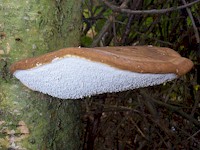 |
CapThis very common polypore is grey-brown at first and almost spherical, flattening and turning browner on top and white underneath as it matures. 10 to 25cm in diameter and 2 to 6cm thick when fully mature, the fruiting bodies arise singly but there are often several on the same host tree so that from a distance they look like a series of steps. |
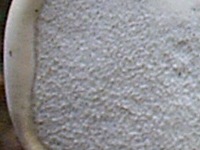 |
Tubes and PoresThe small white tubes are packed together at a density of 3 or 4 per mm; they are between 1.5 and 5mm deep and terminate in white pores that turn buff as they age. |
SporesCylindrical to ellipsoidal, smooth; 4-6 x 1.3-2μm. Spore printWhite. |
|
Odour/taste |
Bitter tasting, when cut these polypores have a faint but not unpleasant 'mushroomy' odour. |
Habitat & Ecological role |
Piptoporus betulinus is almost exclusively restricted to dead or dying birch trees. The brackets are annual but may persist thyrough one winter. The Birch Polypore is parasitic on living trees, but it can also live as a saprobe once the tree has died and so is able to fruit in subsequent years until the trunk rots away. |
Season |
Although you may see these bracket fungi persisting throughout the year, they are annuals and in Britain they release spores in late summer and autumn. |
Similar species |
Mature specimens are shaped very much like the Dryad's Saddle fungus, Polyporus squamosus, but it is difficult to confuse this polypore with any other species because of its distinctive colouring and specific restriction to birch trunks. |
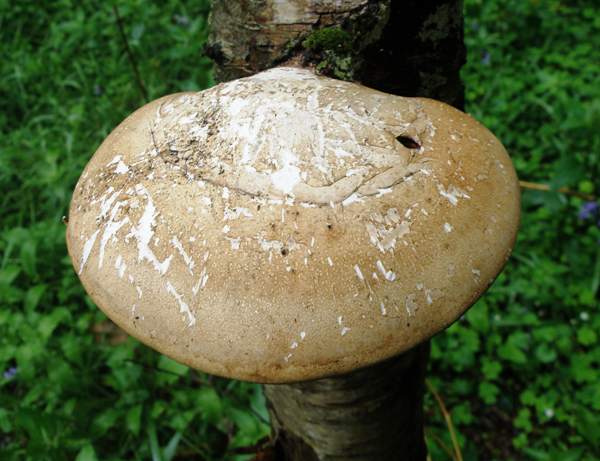
Culinary Notes
This is a tough, bitter fungus. Although young specimens are reportedly edible they are of poor quality and in my opinion not worth collecting.
Reference Sources
Fomitopsis betulina (Bull.) B.K. Cui, M.L. Han & Y.C. Dai, in Han, Chen, Shen, Song, Vlasák, Dai & Cui, Fungal Diversity 80: 359 (2016)
Mattheck, C., and Weber, K. Manual of Wood Decays in Trees. Arboricultural Association 2003.
Pat O'Reilly, Fascinated by Fungi, 2016.
Capasso L (Dec. 1998), "5300 years ago, the Ice Man used natural laxatives and antibiotics", Lancet 352 (9143): 1864
Schlegel B, Luhmann U, Härtl A, Gräfe U. (Sep 2000), 'Piptamine, a new antibiotic produced by Piptoporus betulinus Lu 9-1.', J Antibiot (Tokyo) 53 (9): 973–4
BMS List of English Names for Fungi
Dictionary of the Fungi; Paul M. Kirk, Paul F. Cannon, David W. Minter and J. A. Stalpers; CABI, 2008
Taxonomic history and synonym information on these pages is drawn from many sources but in particular from the British Mycological Society's GB Checklist of Fungi.
Fascinated by Fungi. Back by popular demand, Pat O'Reilly's best-selling 450-page hardback book is available now. The latest second edition was republished with a sparkling new cover design in September 2022 by Coch-y-Bonddu Books. Full details and copies are available from the publisher's online bookshop...

